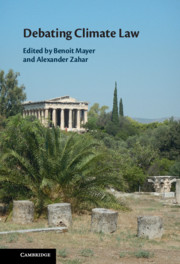Book contents
- Debating Climate Law
- Debating Climate Law
- Copyright page
- Contents
- Contributors
- Acknowledgements
- Abbreviations
- Introduction
- Debate 1: Customary Law
- Debate 2: The ILC’s Role
- Debate 3: CBDR Principle
- Debate 4: Compliance
- Debate 5: Climate Litigation
- Debate 6: Human Rights
- Debate 7: Historical Responsibility
- Debate 8: Climate Migration
- Debate 9: Negative-Emission Technologies
- Debate 10: Solar Radiation Management
- Debate 11: Climate Assessment
- Reflection 1: Adaptation
- Reflection 2: Loss and Damage
- Reflection 3: Disappearing States
- State Extinction Through Climate Change
- Reflection 4: Climate Finance
- Reflection 5: Non-State Actors
- Reflection 6: Regime Inconsistency
- Reflection 7: Aesthetics
- Conclusion
- Index
State Extinction Through Climate Change
from Reflection 3: Disappearing States
Published online by Cambridge University Press: 15 June 2021
- Debating Climate Law
- Debating Climate Law
- Copyright page
- Contents
- Contributors
- Acknowledgements
- Abbreviations
- Introduction
- Debate 1: Customary Law
- Debate 2: The ILC’s Role
- Debate 3: CBDR Principle
- Debate 4: Compliance
- Debate 5: Climate Litigation
- Debate 6: Human Rights
- Debate 7: Historical Responsibility
- Debate 8: Climate Migration
- Debate 9: Negative-Emission Technologies
- Debate 10: Solar Radiation Management
- Debate 11: Climate Assessment
- Reflection 1: Adaptation
- Reflection 2: Loss and Damage
- Reflection 3: Disappearing States
- State Extinction Through Climate Change
- Reflection 4: Climate Finance
- Reflection 5: Non-State Actors
- Reflection 6: Regime Inconsistency
- Reflection 7: Aesthetics
- Conclusion
- Index
Summary
This chapter captures the controversy on ‘state extinction’ through climate change. Sea-level rise and changing weather patterns, among other impacts of climate change, are likely to cause some low-lying Small-Island Developing States (SIDS) to be uninhabitable in the coming decades, even before SIDS territory ‘sinks’ out of sight. Academic debates have offered various proposals on what might happen to the remnants of the states concerned, if they continue to exist at all, and the rights of these territorially orphaned entities under various regimes. Sharon concludes that there is one and only one legal avenue for the—very slight—possibility that statehood would continue after the land is gone.
Keywords
- Type
- Chapter
- Information
- Debating Climate Law , pp. 349 - 364Publisher: Cambridge University PressPrint publication year: 2021

